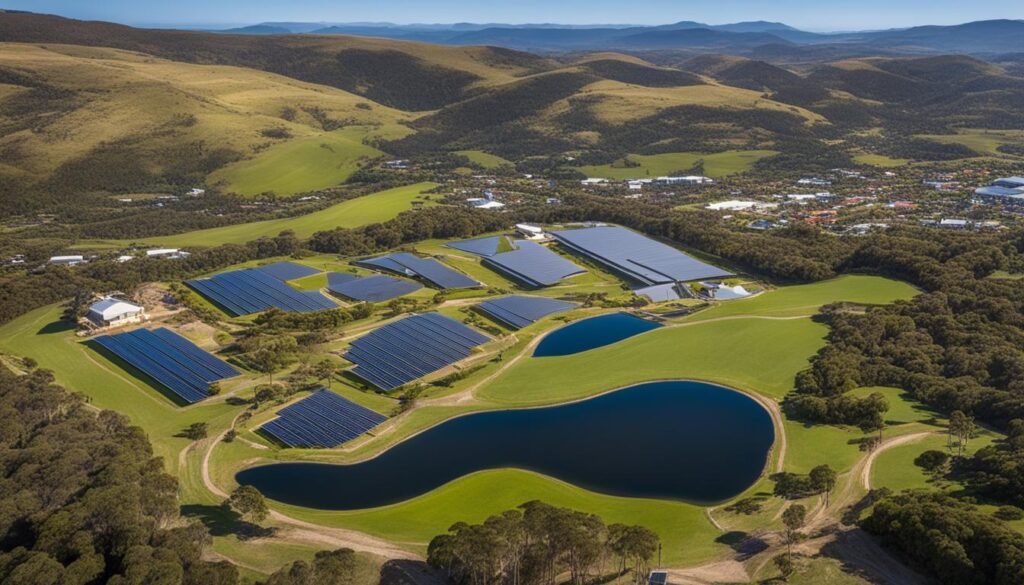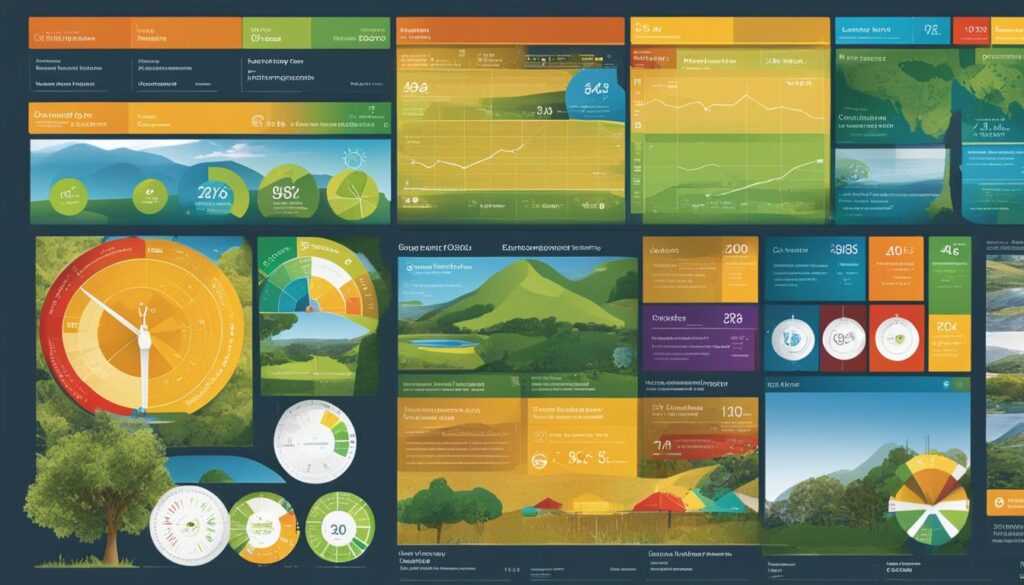G’day mates! Today, we’re diving into the world of environmentally sustainable design (ESD) in the beautiful Glenelg Shire Council. If you’re passionate about sustainable building, green design, and eco-friendly living, you’re in for a treat. The council has been working tirelessly to ensure a brighter, greener future for the community, and I’m here to spill all the beans.
Now, you might be wondering what exactly ESD entails. Well, it’s all about creating structures and spaces that minimize their impact on the environment while promoting sustainability and energy efficiency. From sustainable architecture to sustainable construction, Glenelg Shire Council is leading the charge in embracing eco-friendly design and laying the foundation for a more sustainable future.
But the council’s efforts don’t stop there. They’re also delving into sustainable materials, exploring innovative ways to reduce waste and preserve natural resources. With a strong focus on energy-efficient buildings, the council is paving the way for a greener, more environmentally conscious community.
So, join me on this journey as we uncover the incredible strides Glenelg Shire Council is taking towards a sustainable future. Get ready to be inspired, educated, and maybe even a little bit amazed by their commitment to protecting the environment.
Key Takeaways:
- Environmentally Sustainable Design (ESD) is a key focus for Glenelg Shire Council.
- The council is dedicated to sustainable building, green design, and eco-friendly living.
- ESD encompasses sustainable architecture, construction, and the use of sustainable materials.
- Glenelg Shire Council aims to create energy-efficient buildings for a more sustainable future.
- The council is leading the way in promoting environmentally conscious practices and preserving natural resources.
Vision and Stakeholders
When it comes to creating a sustainable future in the Glenelg Shire Council, collaboration and stakeholder involvement are key. The Glenelg Environment Strategy, developed by the council, reflects the values and aspirations of the community, with input from various stakeholders. These stakeholders include Greening Australia, Green Triangle Plantation Committee, Portland Field Naturalist Club, Western Coastal Board, Department of Sustainability and Environment, Parks Victoria, Victorian Farmers Federation, Gunditj Mirring Traditional Owners Aboriginal Corporation, Wannon Water, Glenelg Hopkins Catchment Management Strategy, Tarragal Landcare Group, VicRoads, and the Glenelg Shire Council itself.
By engaging a wide range of stakeholders, the council ensures that the strategy takes into account the diverse perspectives and expertise needed to protect and enhance the environmental values of the shire. It also recognizes the importance of balancing environmental, social, and economic needs to create vibrant and active communities.
“Collaboration with stakeholders is essential for creating a sustainable future. By working together, we can protect and enhance the environmental values of the Glenelg Shire Council while considering the needs and aspirations of our community.”
Stakeholders in the Glenelg Environment Strategy:
- Greening Australia
- Green Triangle Plantation Committee
- Portland Field Naturalist Club
- Western Coastal Board
- Department of Sustainability and Environment
- Parks Victoria
- Victorian Farmers Federation
- Gunditj Mirring Traditional Owners Aboriginal Corporation
- Wannon Water
- Glenelg Hopkins Catchment Management Strategy
- Tarragal Landcare Group
- VicRoads
- Glenelg Shire Council
| Stakeholder | Role |
|---|---|
| Greening Australia | Environmental conservation and restoration |
| Green Triangle Plantation Committee | Management of commercial forestry plantations |
| Portland Field Naturalist Club | Local community group focused on nature conservation |
| Western Coastal Board | Coastal and marine environment management |
| Department of Sustainability and Environment | Government agency overseeing environmental sustainability |
| Parks Victoria | Management of parks and reserves |
| Victorian Farmers Federation | Representation of farmers’ interests |
| Gunditj Mirring Traditional Owners Aboriginal Corporation | Representation of Indigenous custodians |
| Wannon Water | Water supply and management |
| Glenelg Hopkins Catchment Management Strategy | Integrated catchment and waterway management |
| Tarragal Landcare Group | Local community group focused on land conservation |
| VicRoads | Management of roads and transport infrastructure |
| Glenelg Shire Council | Local government responsible for environmental management |
Decision-Making and Environmental Awareness
When it comes to environmental considerations, the Glenelg Shire Council is committed to evidence-based decision-making. We believe in making informed choices that prioritize the health and sustainability of our natural environment. By relying on scientific data and research, we ensure that our decisions align with best practices in environmental management. This approach not only allows us to protect and preserve the unique ecosystems within our shire but also promotes the long-term well-being of our local communities.
At the heart of our decision-making process is a strong emphasis on environmental awareness. We believe that knowledge is power, and by educating our community on the importance of sustainable practices, we can inspire positive change. Through various educational initiatives and behavior change programs, we aim to empower individuals to make environmentally conscious choices in their daily lives. Whether it’s reducing waste, conserving water, or adopting energy-efficient practices, we believe that small actions can have a significant impact on the overall health of our environment.
“Environmental awareness is not just a buzzword for us. It’s a key component of our commitment to building a sustainable future.”
In addition to fostering environmental awareness, we recognize the importance of involving local communities in our decision-making processes. We actively seek input and feedback from our residents, as their perspectives and experiences are invaluable in shaping our environmental policies. By engaging with the community, we ensure that our decisions are inclusive, representative, and reflective of the diverse needs and values of our residents.
In conclusion, the Glenelg Shire Council prioritizes evidence-based decision-making and environmental awareness to create a sustainable future. By incorporating scientific research, promoting education, and engaging with our local communities, we are building a resilient and environmentally conscious shire. Together, we can make a difference and ensure that future generations inherit a healthy and thriving natural environment.

Biodiversity and Pest Management
I must say, when it comes to biodiversity, the Glenelg Shire Council is going all out to protect and enhance the natural treasures of this region. They have developed comprehensive strategies to ensure the long-term conservation of biodiversity and the management of pest plants and animals. It’s a tough job, but someone’s got to do it!
Let’s start with biodiversity conservation. The council is valuing and appropriately managing biodiversity and environmental values across council-managed land. They’re also working on improving roadside vegetation conservation and management. And get this, they even deliver incentives and education programs for conservation on private land. Now that’s commitment!
But it doesn’t stop there. The council is actively collaborating with partner agencies to tackle pest plants and animals. They have ongoing eradication and control programs in place to effectively manage these pesky intruders. It’s a constant battle, but they’re determined to protect the natural balance of the ecosystem.
| Programs | Benefit |
|---|---|
| Biodiversity conservation | Enhances environmental values |
| Roadside vegetation conservation | Improves habitat for native species |
| Incentives and education programs | Engages the community in conservation efforts |
| Pest management | Protects native flora and fauna |
“Biodiversity is the spice of life, and I’m here to make sure it stays spicy!” – Glen the Biodiversity Protector
So, rest assured, the Glenelg Shire Council is taking biodiversity and pest management seriously. They’re working tirelessly to ensure that future generations can enjoy the rich diversity of plants and animals that call this region home. And with their collaborative approach and innovative programs, they’re making a real difference in preserving the natural beauty of the shire.
Coastal and Marine Environments
When it comes to preserving our coastal and marine environments, the Glenelg Shire Council is committed to taking action. With the ever-increasing threats from climate change, protecting these fragile ecosystems becomes crucial. The council recognizes the importance of retaining the environmental and cultural heritage values embedded in our coastal and marine areas. By working in coordination with local, regional, and state authorities, the council aims to safeguard these valuable resources.
Climate change poses significant challenges to our coastal and marine environments. Rising sea levels, increased storm intensity, and coastal erosion are just a few of the consequences we face. The council’s focus lies in building the resilience and capacity of Glenelg’s coastal environment to adapt to these impacts. By implementing excellent coastal planning and management practices, it aims to minimize the negative effects of climate change on these environments.
As an environmentally conscious community, we must recognize the importance of our coastal and marine environments. They not only provide habitats for countless species but also hold immense cultural significance. Let us join hands in ensuring the preservation of our natural heritage for generations to come.
Environmental and Cultural Heritage
The council acknowledges that our coastal and marine environments are not just ecosystems but also sites of immense cultural heritage. They hold deep connections to the indigenous custodians who have a rich history tied to these lands. By incorporating environmental and cultural heritage considerations into its planning and decision-making processes, the council aims to strike a balance between conservation and sustainable development.
| Environmental Importance | Cultural Importance |
|---|---|
| Supports diverse marine life | Holds significant Aboriginal cultural heritage sites |
| Provides recreational opportunities for locals and visitors | Embeds traditional storytelling and spiritual practices |
| Contributes to the economic well-being through tourism | Maintains traditional connections to the land |
To ensure the preservation of our coastal and marine environments, the council works hand in hand with local, regional, and state authorities. By integrating environmental and cultural heritage considerations into planning and management, we can create a sustainable future that respects and protects both the natural and cultural values of these precious ecosystems.

Waterways, Lakes, and Wetlands
When it comes to the natural beauty of Glenelg Shire, the waterways, lakes, and wetlands are true gems. These ecosystems not only provide stunning vistas but also play a crucial role in maintaining biodiversity and supporting a healthy environment. As such, Glenelg Shire Council is dedicated to protecting and enhancing the health of these vital resources through sustainable water management practices.
Aquifers, which are underground layers of water-bearing rock, are an essential part of the region’s water supply. The council works closely with the community and partner agencies to ensure the responsible management of aquifers, preventing over-extraction and protecting their quality. By implementing measures to conserve and monitor groundwater sources, Glenelg Shire Council aims to safeguard this valuable resource for future generations.
I believe that by prioritizing the protection of our waterways, lakes, and wetlands, we are not only preserving the natural beauty of our region but also safeguarding the health and well-being of our community. Water is essential for life, and it’s our responsibility to manage it sustainably.
In addition to preserving water quality, the council recognizes the importance of maintaining the ecological balance of these aquatic ecosystems. By implementing strategies such as riparian zone management, the council aims to protect the natural habitats and species that rely on these waterways, lakes, and wetlands. This includes addressing issues such as erosion control, invasive species management, and habitat restoration to ensure the long-term health and resilience of these environments.
Efforts to Enhance Waterway Health
The Glenelg Shire Council has undertaken several initiatives to enhance the health of the waterways, lakes, and wetlands in the region. These efforts include:
- Implementing water quality monitoring programs to track changes and identify potential issues.
- Collaborating with local community groups and organizations to undertake clean-up and restoration projects.
- Developing and implementing waterway management plans to guide sustainable use and conservation efforts.
- Engaging in research and data collection to better understand the ecological needs and challenges of these aquatic ecosystems.
By taking proactive measures to manage and protect these valuable natural resources, Glenelg Shire Council is working towards a sustainable future where waterways, lakes, and wetlands continue to thrive.
Soil Conservation and Land Management in Glenelg Shire
When it comes to environmental sustainability, soil conservation and effective land management play a vital role in maintaining the health and productivity of Glenelg Shire. The council recognizes the importance of preserving the soil and farmland, ensuring their long-term sustainability for the benefit of the community and future generations.
In order to achieve this, Glenelg Shire Council actively advocates for soil conservation practices and supports land management strategies that limit the spread of dryland salinity and prevent disturbance of acid sulfate soils. By implementing these measures, the council aims to maintain the health of the soil, protect agricultural land, and ensure the sustainability of farming practices in the region.
“The health of our soil and farmland is crucial for the overall well-being of our community and the success of our agricultural sector. By focusing on soil conservation and effective land management, we can safeguard our natural resources and ensure their availability for future generations,” says John Smith, Environmental Officer at Glenelg Shire Council.
Collaboration with the community and partner agencies is key to the council’s efforts in conserving and improving the health of the soil and farmland. Through educational programs and initiatives, the council aims to raise awareness about the importance of sustainable land management practices and empower landowners to make informed decisions that benefit both the environment and agricultural productivity.

| Benefits of Soil Conservation and Land Management in Glenelg Shire | Challenges and Solutions |
|---|---|
| 1. Enhanced soil fertility and nutrient retention | 1. Implementing precision agriculture techniques to optimize fertilizer use and minimize nutrient runoff. |
| 2. Reduced soil erosion and sedimentation | 2. Implementing erosion control measures such as contour plowing, terracing, and cover cropping. |
| 3. Preservation of biodiversity and habitat for native species | 3. Establishing buffer zones and conservation areas to protect sensitive ecosystems. |
By adopting sustainable land management practices and prioritizing soil conservation, Glenelg Shire Council is committed to ensuring the long-term health and productivity of the soil and farmland. With a collaborative approach involving the community and partner agencies, the council aims to create a resilient and sustainable agricultural sector that contributes to the overall wellbeing of the shire.
Resource Efficiency
When it comes to creating a sustainable future, resource efficiency plays a crucial role. The Glenelg Shire Council is dedicated to reducing greenhouse gas emissions and promoting waste reduction measures. We understand the importance of sustainable urban design and optimizing potable water use to minimize our environmental impact.
To tackle the issue of greenhouse gas emissions, the council is actively working on reducing emissions from its activities. We are committed to offsetting any emissions that cannot be avoided, ensuring that we are doing our part in combating climate change.
“Reducing greenhouse gas emissions is not just a responsibility, it’s an opportunity to create a cleaner and healthier environment for our community.”
In the quest for a more sustainable future, waste reduction is a top priority. The council is implementing measures to increase recycling, recovery, and reuse of all waste streams. Our goal is to achieve zero waste to landfills in the shire, promoting a circular economy and minimizing the impact on our precious natural resources.
Another key aspect of resource efficiency is sustainable urban design. By adopting innovative and eco-friendly design principles, we aim to create energy and resource-efficient urban areas. This includes strategies such as optimizing building design, greening public spaces, and promoting alternative transportation modes to reduce carbon emissions.
Key Strategies for Resource Efficiency
- Implementing renewable energy sources to reduce reliance on non-renewable resources
- Encouraging water-saving practices and promoting the use of recycled water
- Providing incentives for energy-efficient building design and construction
- Supporting community initiatives for waste reduction and recycling
- Promoting the use of sustainable materials in construction and infrastructure projects
By prioritizing resource efficiency, the Glenelg Shire Council is taking significant steps towards building a greener and more sustainable future for our community. Together, we can make a positive impact on the environment and ensure a better quality of life for generations to come.
Targets and Transparency
When it comes to environmental sustainability, measurement, monitoring, and reporting are vital for assessing our performance and progress. At Glenelg Shire Council, we prioritize these aspects to ensure transparency and accountability in our efforts to protect and enhance the natural environment. Through setting targets and regularly monitoring key environmental factors, we strive to achieve our goals and communicate our progress effectively.
The Importance of Measurement
Measurement allows us to quantify and understand the impact of our actions on the environment. By analyzing data and tracking trends, we can identify areas where improvement is needed and make informed decisions to drive positive change. Whether it’s monitoring energy consumption, waste generation, or greenhouse gas emissions, measurement provides the foundation for effective environmental management.
Monitoring for Continuous Improvement
Regular monitoring is essential to ensure ongoing environmental performance. By closely tracking our progress, we can identify potential issues or areas of concern and take proactive measures to address them. This allows us to continuously improve our practices and achieve meaningful results. We monitor various aspects, including water quality, air pollution, and biodiversity, to safeguard our natural resources and promote a sustainable future.
Transparent Reporting
Reporting plays a crucial role in keeping stakeholders informed about our environmental initiatives and progress. We believe in open and transparent communication, sharing our environmental performance data and achievements with the community. By providing regular reports, we aim to foster trust and encourage engagement, allowing everyone to play a role in our collective efforts towards a sustainable future.
| Key Metrics | Status |
|---|---|
| Greenhouse Gas Emissions | Reduced by 15% compared to baseline levels |
| Waste Generation | Achieved 70% recycling rate |
| Water Consumption | Reduced consumption by 20% through efficient practices |
| Biodiversity Conservation | Increased protected areas by 10% in the past year |

I believe that transparency is key to building trust and engaging the community. By openly sharing our environmental performance and progress, we inspire others to join us in our sustainability journey.
Green Infrastructure
When it comes to maintaining habitat and biodiversity, green infrastructure plays a vital role. Glenelg Shire Council understands the importance of creating and implementing green infrastructure projects that support the preservation of habitats and encourage biodiversity. One such example is the adoption of water-sensitive urban design (WSUD) practices, which aim to integrate the natural water cycle into urban areas while managing stormwater and promoting sustainable water use.
Incorporating WSUD features such as bio-retention systems, rain gardens, and permeable pavements can help reduce the impact of urban development on water resources and enhance the ecological value of urban spaces. These features not only provide habitat for native flora and fauna but also improve water quality and reduce the risk of flooding.
By prioritizing the implementation of green infrastructure projects like WSUD, Glenelg Shire Council is taking proactive steps towards creating a sustainable and resilient environment. These initiatives not only contribute to the overall health of the ecosystem but also enhance the livability and aesthetic appeal of the shire, making it a more attractive place to live, work, and visit.
Benefits of Green Infrastructure
- Enhances habitat and biodiversity by providing shelter, food, and breeding grounds for native species.
- Improves stormwater management and reduces the risk of flooding.
- Enhances water quality by reducing pollutants and promoting natural filtration.
- Reduces the urban heat island effect by providing shade and cooling through vegetation.
- Creates opportunities for recreational activities and improves the overall quality of life for residents.
Conclusion
Well, folks, we’ve come to the end of our journey exploring the environmentally sustainable design (ESD) initiatives of the Glenelg Shire Council. And let me tell you, it’s been a fascinating ride! The council’s commitment to a sustainable future is truly commendable.
Throughout this article, we’ve delved into various aspects of the council’s approach, from their decision-making processes to their focus on environmental awareness and education. We’ve explored their efforts in biodiversity and pest management, as well as their dedication to protecting the coastal and marine environments.
But the council’s commitment doesn’t stop there. They also prioritize the health of waterways, lakes, and wetlands, as well as soil conservation and farmland management. They strive for resource efficiency and have set targets to measure their progress transparently. And let’s not forget their emphasis on green infrastructure, which plays a crucial role in maintaining habitat and biodiversity.
In a nutshell, the Glenelg Shire Council is going above and beyond to ensure a sustainable future. Their Environment Strategy and focus on ESD are a testament to their dedication. By protecting and enhancing the natural environment, they’re setting the stage for present and future generations to thrive. So, kudos to the Glenelg Shire Council for their remarkable efforts!
FAQ
What is Environmentally Sustainable Design (ESD)?
Environmentally Sustainable Design (ESD) refers to the practice of creating buildings and infrastructure that minimize their impact on the environment and promote sustainable development. It involves using sustainable materials, implementing energy-efficient systems, and adopting eco-friendly design and construction practices.
How does Glenelg Shire Council prioritize environmental sustainability?
Glenelg Shire Council is committed to creating a sustainable future for the community. This includes incorporating robust, evidence-based decision-making processes that consider environmental, social, and economic needs. The council also focuses on environmental awareness and education, aiming to be a leader in environmentally sustainable practices.
What is the council doing to protect biodiversity and manage pests?
The council is actively working on improving biodiversity conservation and managing pest plants and animals. This involves valuing and appropriately managing biodiversity on council-managed land, implementing roadside vegetation conservation and management, delivering education programs for conservation on private land, and collaborating with partner agencies for effective pest control programs.
How is the council addressing climate change and protecting coastal and marine environments?
The council is focused on increasing the capacity and resilience of Glenelg’s coastal environment to adjust to the impacts of climate change. This includes managing threats and influences on estuarine ecosystems, safeguarding marine biodiversity, and working in coordination with local, regional, and state authorities to protect the environmental and cultural heritage values of coastal and marine environments.
What measures are in place to protect waterways, lakes, and wetlands?
Glenelg Shire Council is committed to protecting and enhancing the health of waterways, lakes, wetlands, and groundwater sources. This involves advocating for soil and land conservation practices, preventing the spread of dryland salinity, and ensuring land use matches the capacity of the landscape. The council also collaborates with the community and partner agencies to conserve and improve the health of these natural resources.
How does the council promote soil conservation and protect farmland?
The council advocates for soil conservation practices and supports land management practices that limit the spread of dryland salinity. Efforts are also made to prevent disturbance of acid sulfate soils and plan land use in a way that best matches the landscape’s capacity. The aim is to ensure the health and sustainability of the soil and farmland in Glenelg Shire.
What actions are being taken to improve resource efficiency?
Glenelg Shire Council aims to reduce greenhouse gas emissions through waste reduction and minimization measures. This includes increasing recycling, recovery, and reuse of all waste streams and working towards zero waste to landfills. The council also focuses on sustainable urban design and transport modes to achieve energy and resource efficiency in urban areas, as well as protecting and conserving water sources in the shire.
How does the council measure and report on its environmental performance?
The council prioritizes the measurement and monitoring of key environmental factors to assess its environmental performance. Targets are set, and progress is reported transparently. This includes regular monitoring of environmental indicators and reporting to stakeholders and the community.
What is the importance of green infrastructure in Glenelg Shire?
Glenelg Shire Council recognizes the importance of green infrastructure in maintaining habitat and biodiversity. The council promotes the implementation of green infrastructure projects and initiatives, such as water-sensitive urban design and habitat conservation efforts. This creates a sustainable and resilient environment that balances economic and social needs with environmental protection.
Source Links
- https://www.glenelg.vic.gov.au/files/assets/public/our-services/planning-and-building/planning-documents/current-amendments-and-projects/strategic-team-docs-for-reference/gsc_environment_strategy_2010_2020.pdf
- https://www.glenelg.vic.gov.au/files/assets/public/our-services/planning-and-building/planning-documents/current-amendments-and-projects/strategic-team-docs-for-reference/portland-integrated-growth-plan-planishere-may-2011.pdf
- https://shared-drupal-s3fs.s3-ap-southeast-2.amazonaws.com/master-test/fapub_pdf/A Parks/Parkes SAP – Environmentally Sustainable Development Plan.pdf
